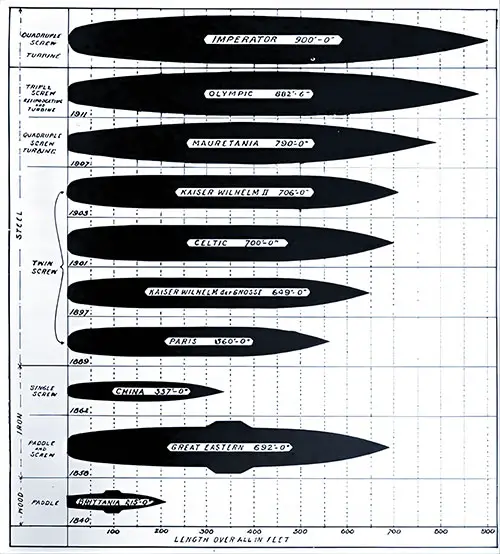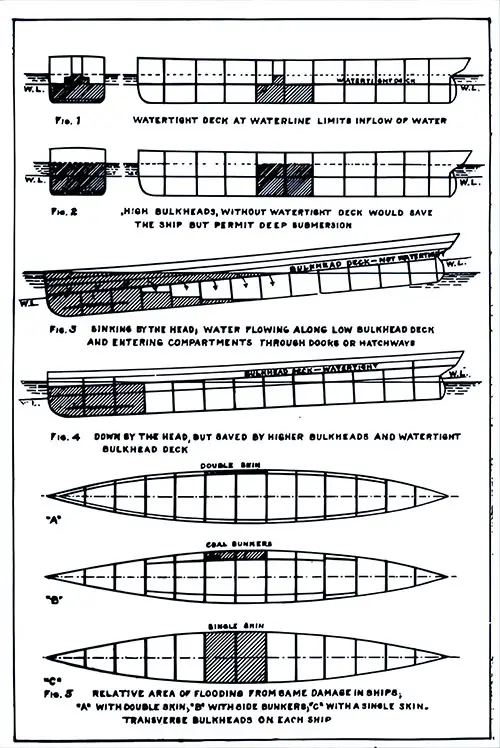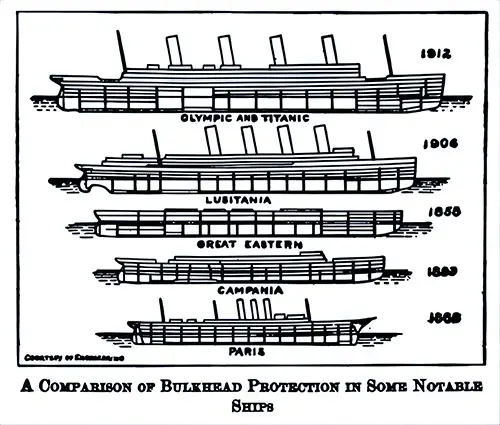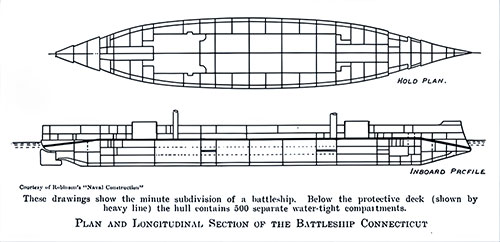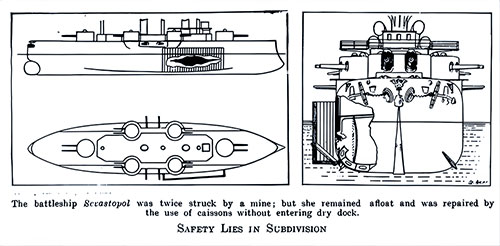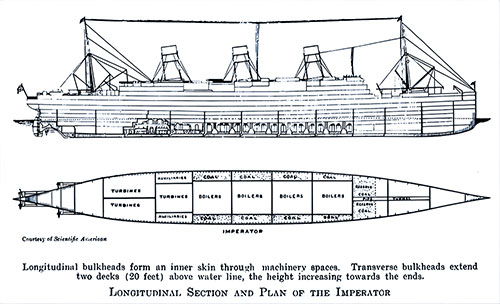Titanic in Focus: Engineering, Safety, and the Lessons of the 1912 Disaster
📌 Explore the 1912 book The Unsinkable Titanic by J. Bernard Walker, featuring rare photos, diagrams, and safety analysis. Learn how Titanic’s bulkheads failed, why lifeboat drills mattered, and how ocean liners changed after the disaster.
Titanic Photographs - The Unsinkable Titanic (1912) 📖🚢🔥
Introduction: A Call for Change After Tragedy
Published just months after the Titanic disaster, The Unsinkable Titanic: Every Ship Its Own Lifeboat by J. Bernard Walker, editor of Scientific American, was one of the earliest books to analyze the ship’s engineering flaws and advocate for safer shipbuilding practices. Walker’s work was not merely a historical account of the sinking but an urgent call to action, urging the maritime industry to rethink watertight compartments, bulkheads, and lifeboat regulations.
For teachers, students, historians, maritime enthusiasts, and genealogists, this collection of photographs, diagrams, and illustrations offers a powerful glimpse into early 20th-century shipbuilding, safety concerns, and the rapid evolution of ocean travel. This primary source material is invaluable for research papers, historical analysis, and genealogy studies, as it showcases how the Titanic’s legacy shaped modern maritime engineering.
Images pertaining to the Titanic disaster or its aftermath, published in An Unsinkable Titanic: Every Ship Its Own Lifeboat by J. Bernard Walker, Editor of the Scientific American. Published New York: Dodd, Mead and Company, 1912. Published, July, 1912.
Mr. Walker, who is a distinguished engineer and the editor of the Scientific American, advocates and explains certain changes in ship construction, which it is believed will prevent such disasters as that of the Titanic and which have been adopted by the White Star Line.

Stoke Hole of a Transatlantic Liner. The Unsinkable Titanic, 1912. GGA Image ID # 107378e999
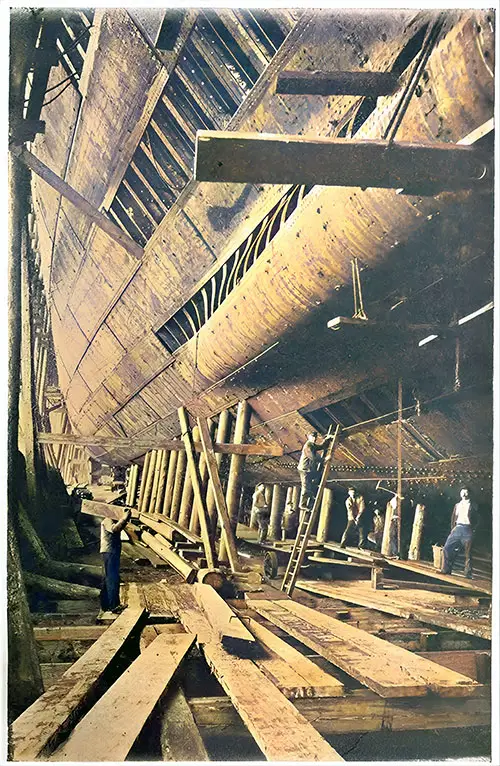
Riveting the Outer Skin on an Ocean Liner. The Unsinkable Titanic, 1912. GGA Image ID # 1073adaf04
Growth of Transatlantic Steamships, 1840-1912. The Unsinkable Titanic, 1912. GGA Image ID # 1073fde953. Click to View a Larger Image.
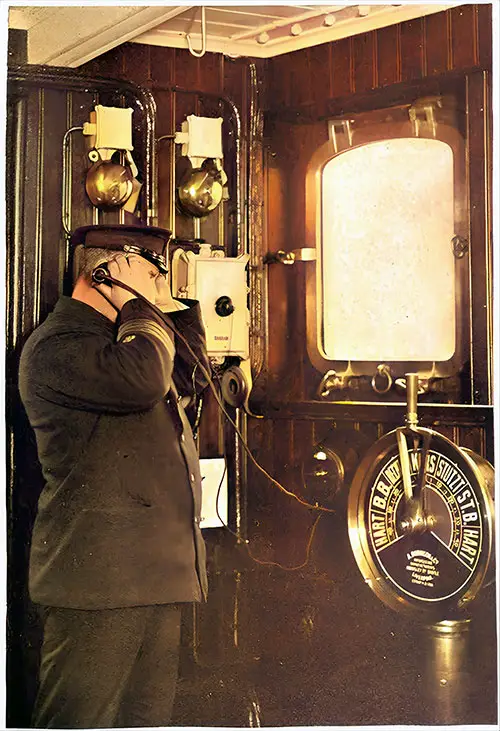
Receiving Submarine Signals on the Bridge of an Ocean Liner. The Unsinkable Titanic, 1912. GGA Image ID # 10744f2b68
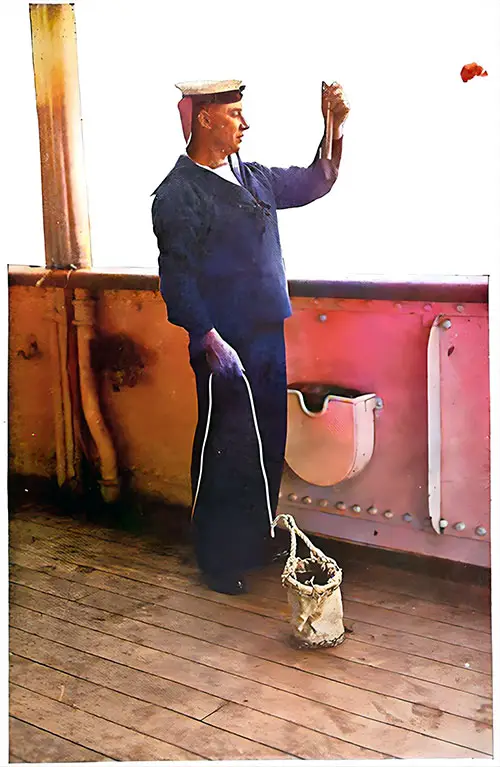
Taking the Temperature of the Water. The Unsinkable Titanic, 1912. GGA Image ID # 1074568b29

Fire Drill on a German Ocean Liner. The Unsinkable Titanic (1912) p,. 21. GGA Image ID # 1074778492
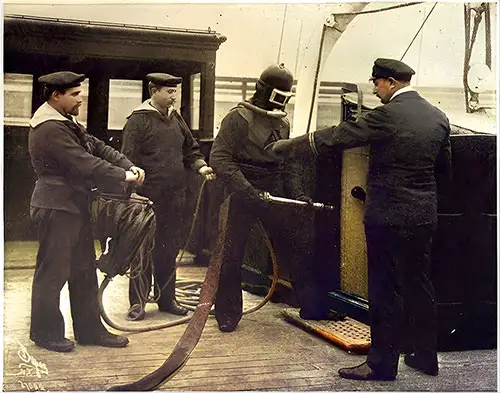
Another Scene of a Fire Drill on a German Ocean Liner. The Unsinkable Titanic, 1912. GGA Image ID # 107478a4bd
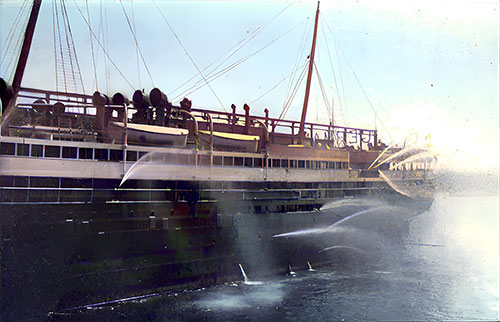
Viewing a Fire Drill on a German Ocean Liner from Another Ship. The Unsinkable Titanic, 1912. GGA Image ID # 10747b92bc
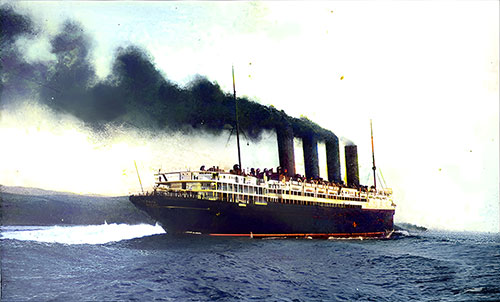
The 44,000 Ton Cunard Ocean Liner RMS Lusitania. The Unsinkable Titanic, 1912. GGA Image ID # 1074d5816d
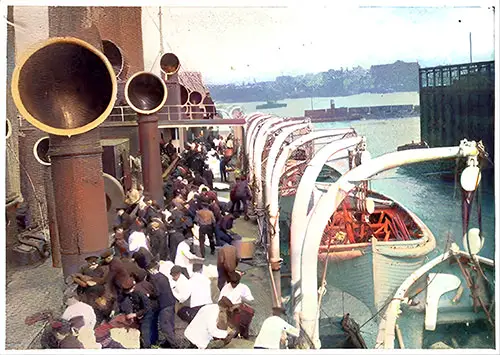
Provisioning the Ship During a Lifeboat Drill. The Unsinkable Titanic, 1912. GGA Image ID # 1075057dcc

Loading and Lowering Lifeboats During a Drill. The Unsinkable Titanic, 1912. GGA Image ID # 1075178d21
Deck Plan of the Boat Deck of the RMS Titanic. The Unsinkable Titanic, 1912. GGA Image ID # 10752aaf8d. Click to View a Larger Image.
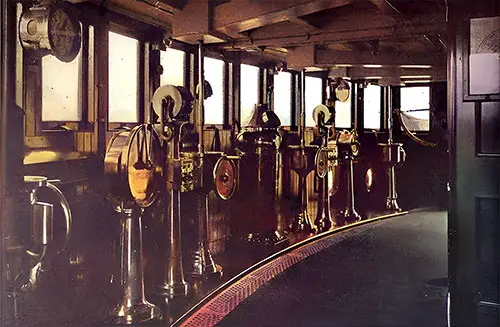
View of the Bridge of an Ocean Liner. The Unsinkable Titanic, 1912. GGA Image ID # 1075684a1d
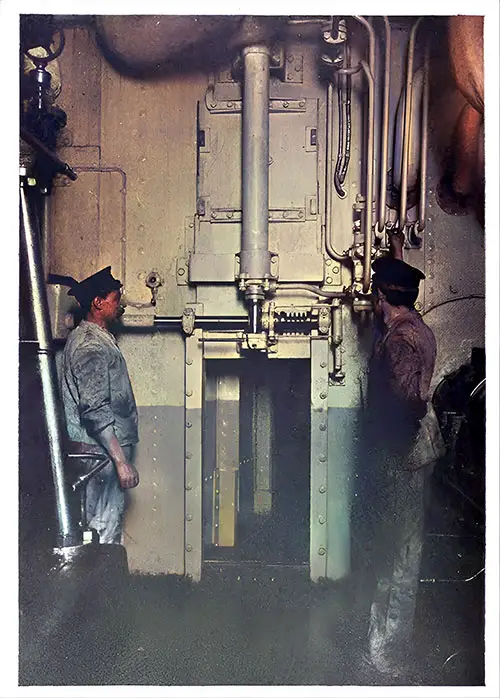
Hydraulically Operated Watertight Door. The Unsinkable Titanic, 1912. GGA Image ID # 1076053222
Diagram of Protective Value of the Bulkheads. The Unsinkable Titanic, 1912. GGA Image ID # 10764c1502. Click to View a Larger Image.
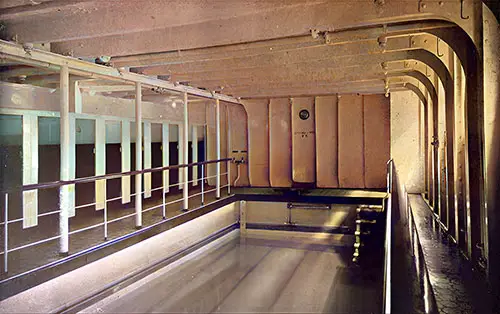
Swimming Pool on the RMS Titanic. The Unsinkable Titanic, 1912. GGA Image ID # 107686fcea
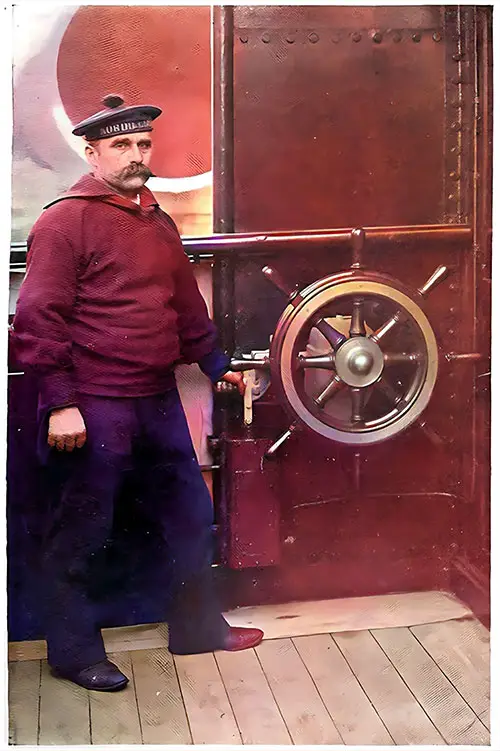
Sailor Closing All Watertight Doors from the Bridge of an Ocean Liner. The Unsinkable Titanic, 1912. GGA Image ID # 1076f52d49
A Comparison of Bulkhead Protection in Some Notable Ships: Olympic and Titanic, Lusitania, Great Eastern, Campania, and Paris. The Unsinkable Titanic, 1912. GGA Image ID # 1077aea24f. Click to View a Larger Image.
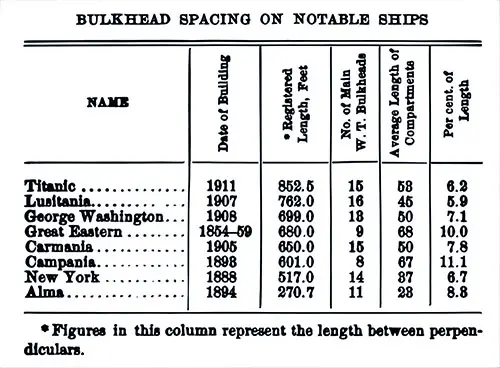
Bulkhead Spacing on Notable Ships: Titanic, Lusitania, George Washington, Great Eastern, Carmania, Campania, New York, and Alma. The Unsinkable Titanic, 1912. GGA Image ID # 10780b9b2e
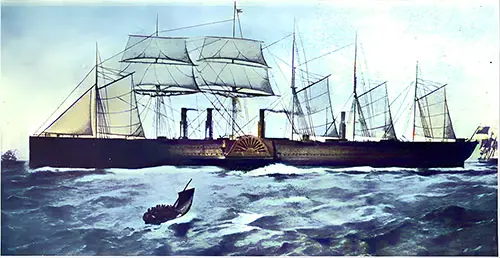
The Great Eastern. The Unsinkable Titanic, 1912. GGA Image ID # 10781a7ad2
The SS Great Eastern is an iron-hulled steamship designed by Isambard Kingdom Brunel and built by John Scott Russell & Co. at Millwall Iron Works on the River Thames in London, England. It holds a significant place in maritime history.
When launched in 1858, the SS Great Eastern was the largest ship ever built. Measuring 692 feet (211 meters) in length, she was only surpassed in size in 1899 by the 705-foot (215-meter), 17,274-gross-ton RMS Oceanic.
Her gross tonnage of 18,915 was surpassed in 1901 by the 701-foot (214-meter) 20,904-gross-ton RMS Celtic, and her passenger capacity of 4,000 was exceeded in 1913 by the 4,234-passenger SS Imperator.
One of the ship's distinctive features was its five funnels, which were later reduced to four, and it also had the largest set of paddle wheels of its time.
The size and innovative design of the SS Great Eastern set new standards in shipbuilding and significantly influenced the future of maritime transportation.
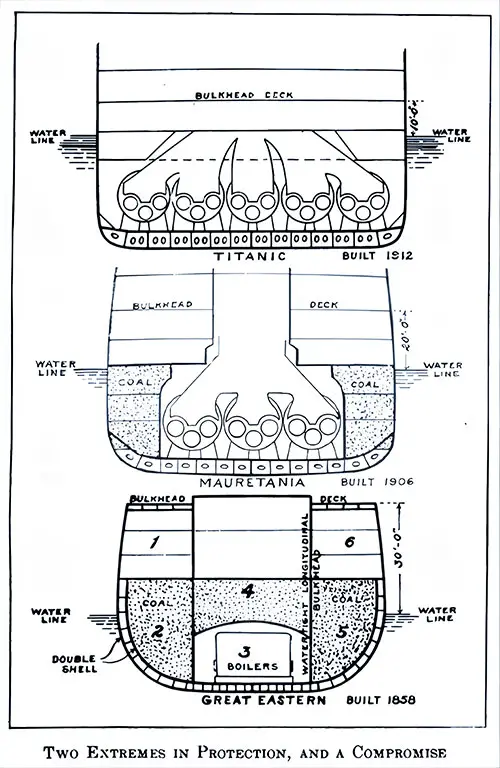
Diagram of Two Extremes in Protection, and a Compromise, showing the Titanic, Mauretania, and the Great Eastern. The Unsinkable Titanic, 1912. GGA Image ID # 1078954479
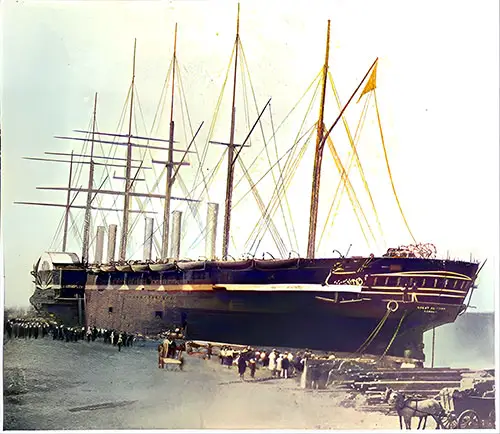
The Great Eastern Docked in New York. The Unsinkable Titanic, 1912. GGA Image ID # 107943407a
50-Years of a Decline in Safety of Construction in Ocean Liners. Watertight Compartments of The Great Eastern Compared to the Titanic. The Unsinkable Titanic, 1912. GGA Image ID # 1079683df4. Click to View a Larger Image.
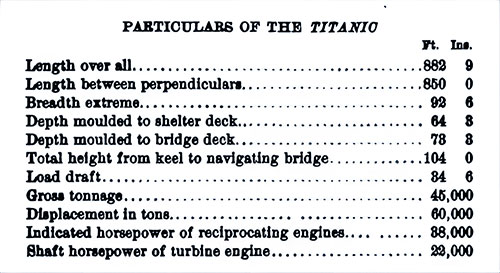
Principal Dimensions and Particulars of the RMS Titanic. The Unsinkable Titanic, 1912. GGA Image ID # 1079a228a2
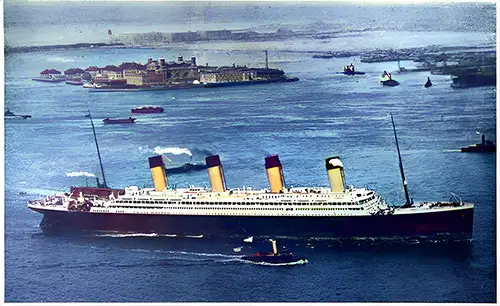
The RMS Olympic Reaches New York on Her Maiden Voyage. The Unsinkable Titanic, 1912. GGA Image ID # 1079f986d2
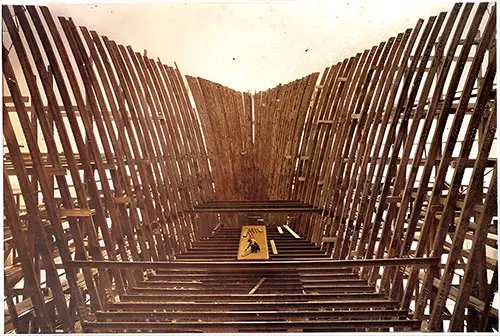
Framing and Some Deck Beams of the SS Imperator. The Unsinkable Titanic, 1912. GGA Image ID # 1079fe1546
Plating Carried Up the Side Forms Inner Skin. The Unsinkable Titanic, 1912. GGA Image ID # 107a18e7ac. Click to View a Larger Image.
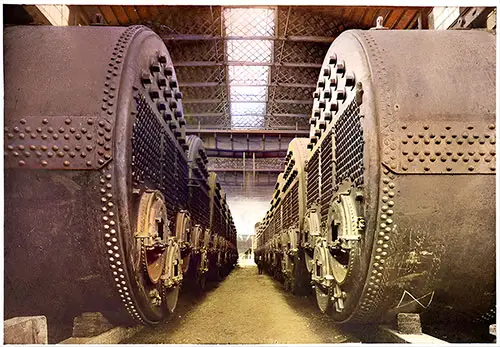
View of the Boilers for the RMS Titanic. The Unsinkable Titanic, 1912. GGA Image ID # 107a1cc2bf
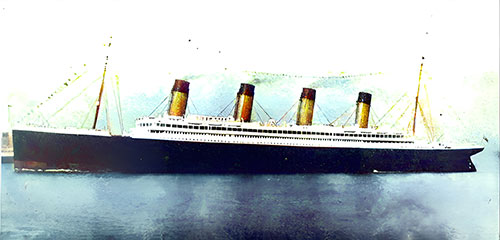
The last photograph of the Titanic taken as she was leaving Southampton on her Maiden Voyage. The Unsinkable Titanic, 1912. GGA Image ID # 100a8db716
The Titanic struck a glancing blow against an under-water shelf of the iceberg, opening up five compartments. Had She been provided with a watertight deck at or near the water Line, the water which entered the ship would have been confined below that deck, and the buoyancy of that portion of the ship above water would have kept her afloat. As it was, the water rose through openings in the decks and destroyed the reserve buoyancy. The Unsinkable Titanic, 1912. GGA Image ID # 100a665876. Click to View a Larger Image.
Comparison of Subdivision in Two Famous Ships. Titanic: Single Skin, 10 Compartments; Mauretania: Double Skin, 34 Compartments. The Unsinkable Titanic, 1912. GGA Image ID # 107a917064. Click to View a Larger Image.
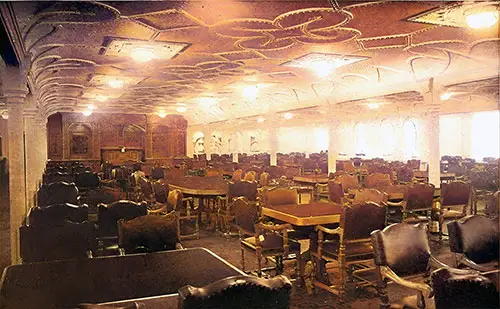
View of the Vast First Class Dining Room on the RMS Titanic. The Unsinkable Titanic, 1912. GGA Image ID # 107ae473a4
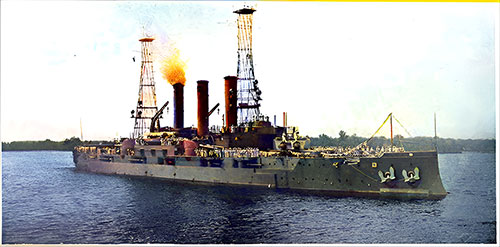
The USS Kansas Battleship. The Unsinkable Titanic, 1912. GGA Image ID # 107afda2a3
The USS Kansas (BB-21) is important in U.S. naval history. As a Connecticut-class pre-dreadnought battleship, she was the fourth of six ships in her class and the second ship of the United States Navy named after the state of Kansas. Launched in August 1905 and commissioned into service in April 1907, the Kansas was armed with a main battery of four 12-inch (305 mm) guns and could reach a top speed of 18 knots (33 km/h; 21 mph).
Plan and Logitoudinal Section of the Battleship USS Connecticut. The Unsinkable Titanic, 1912. GGA Image ID # 107b4570bb. Click to View a Larger Image.

Midship Section of a Battleship. The Unsinkable Titanic, 1912. GGA Image ID # 107c1960cf
Safety Lies in Subdivision. The Battleship Sevastopol Was Struck by a Mine Twice, but It Remained Afloat and Was Repaired Using Caissons Without Entering Dry Dock. The Unsinkable Titanic, 1912. GGA Image ID # 107c398a8c. Click to View a Larger Image.
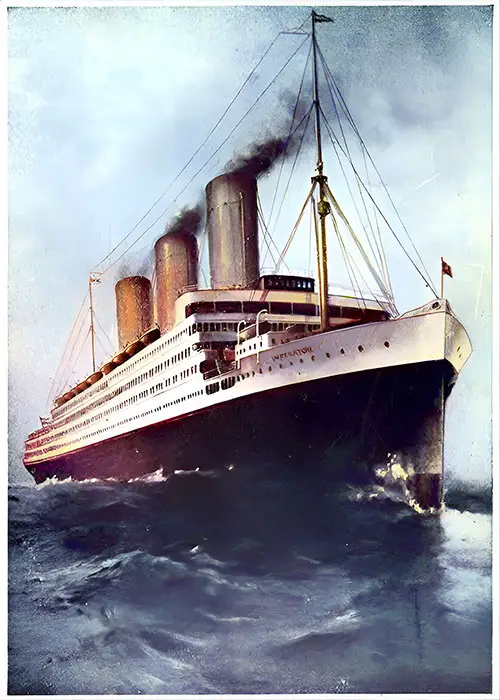
The German Ocean Liner Imperator - Largest Ship Afloat at 65,000 Tons. The Unsinkable Titanic, 1912. GGA Image ID # 107c472c10
Longitudinal Section and Plan of the Imperator. The Unsinkable Titanic, 1912. GGA Image ID # 107c66582b. Click to View a Larger Image.
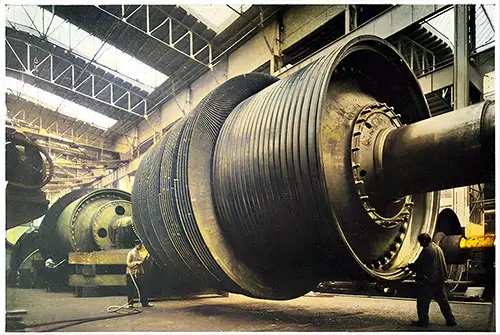
Rotor of the SS Imperator Turbines. The Unsinkable Titanic, 1912. GGA Image ID # 107cff581f
Hold Plan of SS Kronprinzessin Cecilie. This Well-Protected Ship Has Side Coal Bunkers and Inner Skin in Engine Rooms. There Are Thirty-Three Compartments Below the Waterline. The Unsinkable Titanic, 1912. GGA Image ID # 107d2646e0. Click to View a Larger Image.
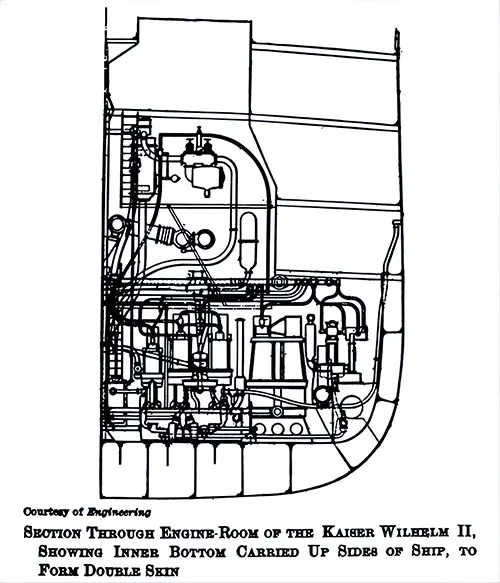
Section Through Engine Room of the Kaiser Wilhelm II Showing Inner Bottom Carried Up Sides of Ship to Form Double Skin. Originally Published in Engineering Magazine. The Unsinkable Titanic, 1912. GGA Image ID # 107d53622c
Key Highlights and Most Engaging Content
1️⃣ The Titanic’s Engineering in Focus: How Was It Built? ⚙️🔩
The collection includes photographs of ship construction, riveting techniques, and steelwork that provide an inside look at how ocean liners were assembled in the early 1900s.
🔹 Noteworthy Image: Riveting the Outer Skin on an Ocean Liner
📌 Significance: This rare image of the Titanic’s hull construction helps students and maritime historians visualize how the ship’s steel plating was secured. It also raises questions about how strong the rivets were in comparison to later shipbuilding improvements.
🔹 Noteworthy Image: View of the Boilers for the RMS Titanic
📌 Significance: The boiler rooms were the heart of Titanic’s power system, yet they were among the first areas to flood after the iceberg collision. This image connects engineering to the ship’s fatal weaknesses.
2️⃣ A Look at Fire and Safety Drills Before the Titanic 🔥🚨
One of the most intriguing sections includes images of fire drills and safety measures aboard German ocean liners, highlighting the contrast between preparedness on different vessels.
🔹 Noteworthy Image: Fire Drill on a German Ocean Liner
📌 Significance: This image raises critical questions about maritime safety culture at the time—why were some ships prepared for emergencies while others (like Titanic) were not?
🔹 Noteworthy Image: Loading and Lowering Lifeboats During a Drill
📌 Significance: The Titanic lacked proper lifeboat drills, a fact that contributed to the chaos on the night of the sinking. This image emphasizes how structured drills could have saved more lives.
3️⃣ How the Titanic Sank: Diagrams and Structural Analysis 📊⚓
Walker’s book is one of the earliest attempts to analyze why the Titanic went down. It includes diagrams comparing the Titanic’s bulkhead structure to other ships, proving that more watertight compartments and double hulls could have prevented the sinking.
🔹 Noteworthy Image: Diagram of Protective Value of the Bulkheads
📌 Significance: This diagram shows how bulkheads worked to prevent flooding—but also why they failed on the Titanic.
🔹 Noteworthy Image: Comparison of Subdivision in Two Famous Ships: Titanic vs. Mauretania
📌 Significance: The Titanic had only 10 compartments compared to Mauretania’s 34, showing that better compartmentalization could have saved the ship.
4️⃣ Lessons from Other Ocean Liners: Safety Innovations 🚢🔍
Walker contrasts the Titanic with other famous ships, such as the Lusitania, Great Eastern, and Kaiser Wilhelm II, demonstrating how their designs either improved or suffered from similar safety flaws.
🔹 Noteworthy Image: 50 Years of a Decline in Safety of Construction in Ocean Liners
📌 Significance: This side-by-side comparison of Titanic and older vessels like the Great Eastern suggests that shipbuilders may have prioritized luxury and size over safety.
🔹 Noteworthy Image: Section Through Engine Room of Kaiser Wilhelm II
📌 Significance: Unlike Titanic, this ship had a reinforced double hull, making it far less vulnerable to flooding.
5️⃣ The Human Element: Titanic’s Last Moments and Aftermath 🕯️⚰️
This section is especially valuable for genealogists and historians, as it includes the last known photograph of the Titanic departing Southampton and images depicting how the iceberg impact led to the ship’s ultimate demise.
🔹 Noteworthy Image: The Last Photograph of the Titanic Leaving Southampton
📌 Significance: This haunting image captures the ship just before disaster, making it one of the most historically significant photos of the Titanic.
🔹 Noteworthy Image: The Titanic Struck a Glancing Blow Against an Underwater Shelf of the Iceberg
📌 Significance: This diagram explains why the iceberg damage was fatal, offering an early engineering perspective on what went wrong.
Relevance for Teachers, Students, Historians, and Genealogists
👩🏫 Teachers & Students:
🔹 This book is a goldmine for primary sources, offering first-hand analysis of ship engineering and safety lessons.
🔹 Encourages critical thinking by comparing Titanic’s structure to other vessels.
🔹 Can be used for STEM and history projects related to engineering failures and maritime safety reforms.
📜 Historians & Maritime Enthusiasts:
🔹 Provides rare photographic evidence from the earliest post-Titanic safety investigations.
🔹 Offers direct insight into pre-WWI shipbuilding techniques and their limitations.
🔹 Helps contextualize Titanic’s impact on maritime laws and safety reforms.
🧬 Genealogists & Family Historians:
🔹 The photos and diagrams help descendants of Titanic passengers understand how the ship operated.
🔹 The book’s focus on lifeboat procedures and safety failures gives insight into why some families survived while others didn’t.
Encouragement for Students: Essay & Research Topics
💡 Need an Essay Topic?
🔹 What does The Unsinkable Titanic reveal about early 20th-century engineering flaws?
🔹 How did the Titanic’s sinking lead to changes in maritime safety?
🔹 Was the Titanic’s failure due to design flaws, human error, or both?
🔹 How did other ships like the Lusitania and Mauretania compare in terms of safety?
🚢 This book isn’t just about the Titanic—it’s about the future of ocean travel. Its lessons shaped the ships we sail on today. 🌊⚓

